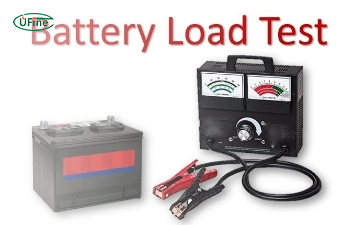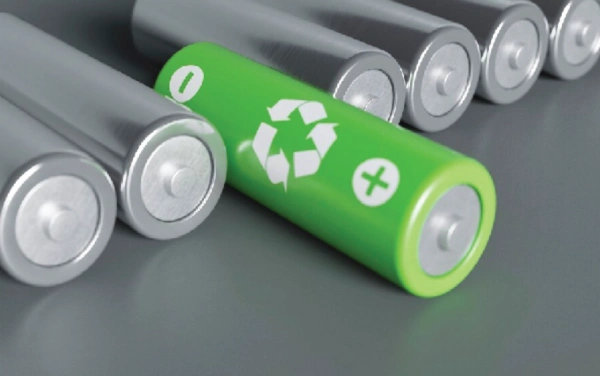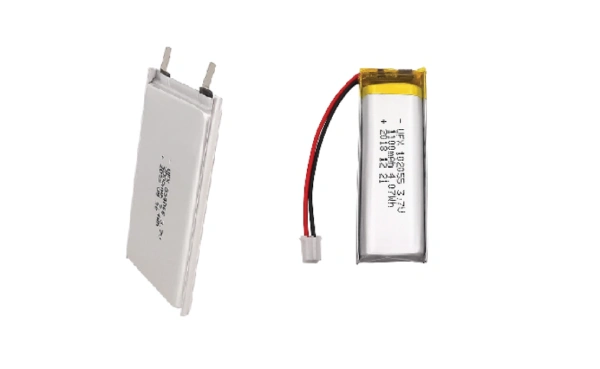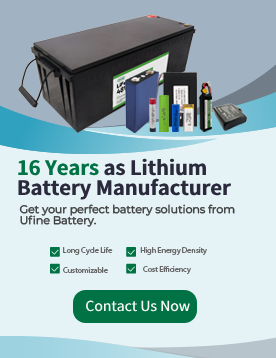
- 1. Classification of lithium battery types by form factor
- 2. Battery size codes explained
- Part 3. Common cylindrical lithium battery sizes
- Part 4. Pouch (polymer) lithium battery sizes
- Part 5. Standard prismatic lithium battery sizes
- Part 5. Button/coin cell sizes
- Part 7. Largest battery size
- Part 8. Smallest battery size
- Part 9. Custom lithium battery sizes and packs
- Part 10. Lithium battery size comparison chart
- Part 11.FAQs
1. Classification of lithium battery types by form factor
Lithium batteries come in several form factors, each suited to specific applications. Here’s a breakdown:
| Form Factor | Shape | Common Uses | Size Flexibility |
|---|---|---|---|
| Cylindrical | Round tubes | Flashlights, power tools, EVs | Moderate |
| Prismatic | Rectangular | Power banks, energy storage systems | Moderate |
| Pouch (Polymer) | Flexible pouch | Smartphones, drones, wearables | High (customizable) |
| Button/Coin | Disc-shaped | Watches, calculators, medical devices | Limited |
Each form factor offers unique advantages in terms of space efficiency, heat dissipation, and scalability.
2. Battery size codes explained
Understanding battery size codes can help you quickly identify the cell’s physical characteristics:
- 18650 → 18mm diameter × 65.0mm length
- 104050 → 10mm thick × 40mm wide × 50mm high
- CR2032 (coin) → 20mm diameter × 3.2mm thickness
These naming conventions are often standardized under IEC (International Electrotechnical Commission) and ANSI (American National Standards Institute) regulations.
Part 3. Common cylindrical lithium battery sizes
The lithium-ion battery is a game changer in the electronic world. So, they come in various standard dimensions. Typically, they are denoted by a combination of their numbers, which show their height, width, and thickness (all in millimeters).
This variety of lithium-ion battery sizes is widely used in different industries for a range of applications, such as electronics and electric vehicles.
The most commonly used lithium-ion cell sizes are 18650 (18mm diameter, 65mm length), 21700 (21mm diameter, 70mm length), and 26650 (26mm diameter, 65mm length).
| Battery Size | Similar Size | Capacity (mAh) | Diameter (mm) | Length (mm) | Uses |
|---|---|---|---|---|---|
| 10180 | N/A | 70 – 100 | 10.1 | 18 | Small devices like Bluetooth earphones, keychain flashlights |
| 10440 | AAA | 250 – 350 | 10 | 44 | Mini flashlights, mini stereos, speakers |
| 14500 | AA | 700 – 1000 | 14 | 50 | LED flashlights, toys, digital cameras |
| 16340 | CR123A | 400 – 900 | 16 | 34 | LED flashlights, laser lights |
| 18350 | N/A | 700 – 1200 | 18 | 35 | Vapes, flashlights, laser pointers |
| 18490 | N/A | 1200 – 1500 | 18 | 49 | LED flashlights, power banks |
| 18650 | / | 1500 – 3500 | 18 | 65 | Laptops, tools, e-bikes, flashlights |
| 21700 | / | 3000 – 5000 | 21 | 70 | E-bikes, solar lights, power tools |
| 26650 | / | 2400 – 5750 | 26 | 65 | RC toys, high-power flashlights |
| 32700 | N/A | 6000 – 9000 | 32 | 70 | EVs, solar storage, backup systems |
| 32650 | / | 5000 – 6500 | 32 | 67.7 | UPS, wind-solar systems, toys |
| 38120 | N/A | 8000 – 12000 | 38 | 120 | EVs, renewable storage, UPS |
| 40152 | N/A | 10000 – 15000 | 40 | 152 | EVs, solar storage, backup systems |
Part 4. Pouch (polymer) lithium battery sizes
Typical Dimensions and Naming
Pouch batteries are usually labeled by their thickness × width × height in millimeters. For example, a “103450” cell is 10 mm thick, 34 mm wide, and 50 mm high.
They are widely used in:
- Tablets and smartphones
- Power banks
Although not as robust as cylindrical cells, prismatic batteries offer better energy density and packaging efficiency.
Advantages:
- Custom dimensions allow perfect integration into thin devices.
- High energy density with reduced packaging weight.
- Ideal for complex-shaped battery compartments.
Applications:
- Smartphones and tablets
- Drones and UAVs
- Wearables like fitness trackers
- Portable medical devices
However, pouch cells are more susceptible to swelling and mechanical stress and require protective casing.
Part 5. Standard prismatic lithium battery sizes
Prismatic lithium batteries are known for their rectangular, hard-case design, offering higher space efficiency and structural integrity compared to cylindrical cells. These batteries are commonly used in applications that require modular battery systems, such as electric vehicles (EVs), solar energy storage, power banks, and Uninterruptible Power Supplies (UPS).
Unlike cylindrical batteries that follow standardized diameter and length codes (e.g., 18650), prismatic batteries vary widely in size depending on the manufacturer and the application. However, some typical configurations and size ranges are widely used across industries.
Common Prismatic Battery Characteristics:
- Voltage Range: 3.2V (LiFePO₄) to 3.7V (NMC, LCO)
- Capacity Range: 2000 mAh to 30,000+ mAh
- Dimensions: Vary by design, commonly from 50 × 70 × 90 mm up to 100 × 200 × 300 mm
- Shell Material: Aluminum or steel casing for safety and durability
- Energy Density: Moderate to high (depending on chemistry)
- Thermal Management: Better than pouch but slightly less efficient than cylindrical cells
Use Case Examples:
- Electric vehicles (EV battery modules)
- Solar and wind energy storage systems
- Home and industrial backup batteries
- Portable power banks and inverter-based systems
Prismatic cells are often selected for systems where modular design and structured packing are more important than absolute energy density. Their rigid rectangular shape makes them ideal for stacked battery modules.
Part 5. Button/coin cell sizes
Button or coin cell lithium batteries are compact and often non-rechargeable. They are named using a four-digit or five-digit code, such as CR2032, where:
- The first two digits indicate the diameter (in mm).
- The last two (or three) digits indicate the height (in tenths of a mm).
Examples:
| Name | Capacity (mAh) | Discharge Current (mA) | Dimensions (mm) | Comments |
|---|---|---|---|---|
| CR927 | 30 | – | 9.5 × 2.7 | Used in LED art and some Lego toys |
| CR1025 | 30 | 0.1 | 10 × 2.5 | – |
| CR1130 | 70 | 0.1 | 11.5 × 3.0 | Rare; used in car security, organizers, pedometers |
| CR1216 | 25 | 0.1 | 12.5 × 1.6 | Used in lighted watches and LED decorator lights |
| CR1220 | 35–40 | 0.1 (CR), 0.03 (BR) | 12.5 × 2.0 | Keychain LED flashlights, some digital cameras |
| CR1225 | 50 | 0.2 | 12.5 × 2.5 | Automobile remotes, digital watches |
| CR1616 | 50–55 | 0.1 | 16 × 1.6 | Automobile key remotes, Game Boy cartridges |
| CR1620 | 75–78 | 0.1 | 16 × 2.0 | Automobile key remotes, early digital watches |
| CR1632 | 140 (CR), 120 (BR) | 0.1 (CR), 0.03 (BR) | 16 × 3.2 | Used in key remotes (e.g. Toyota Prius 2012) |
| CR2016 | 90 | 0.1 (CR), 0.03 (BR) | 20 × 1.6 | Digital watches, LED flashlights |
| CR2025 | 160–165 | 0.2 | 20 × 2.5 | Watches, automobile remotes |
| CR2032 | 225 (CR), 190 (BR) | 0.2 (CR), 0.03 (BR) | 20 × 3.2 | Most common coin cell; motherboards, remotes |
| CR2450 | 610–620 | – | 24.5 × 5.0 | High current devices, long shelf life |
| CR2477 | 1,000 | 0.2 | 24.5 × 7.7 | Highest capacity coin cell, versatile use |
| CR3032 | 500–560 (CR), 500 (BR) | 0.1–0.2 (CR), 0.03 (BR) | 30.0 × 3.2 | Panasonic: used in motherboards, devices |
Part 7. Largest battery size
Some applications demand high-energy storage. In that case, the largest lithium battery sizes are the best option. This application may include electric vehicles, industrial backup power, or renewable energy storage systems. So, large-sized batteries are designed using lithium chemistries so that their battery life and performance can be increased.
Ufine’s largest lithium battery
Ufine is providing an extensive range of lithium batteries. These include the largest size lithium battery, i.e., 48V 100Ah LiFePO4 battery. This battery has high capacity and is specifically built for demanding applications that need reliable and long-lasting power sources.
So, here are some notable features of Ufine’s 48V 100Ah LiFePO4 battery;
- Have stable chemical and thermal properties, so the combustion risk is reduced.
- Durable and have a long lifespan through multiple charge cycles.
- Offers steady voltage for consistent power delivery.
- Eco-friendly, non-toxic, and best for sustainable use.
- Have a fast charging cycle to reduce downtime.
Part 8. Smallest battery size
As we discussed earlier, large-size batteries are used for high-energy applications. So, the smaller lithium batteries are useful for IoT devices, wearable technology, and compact electronic devices. They provide sufficient power in small form factors. That enables the development of portable and lightweight gadgets.
Ufine’s smallest battery size
If we particularly talk about Ufine’s small-size lithium batteries, they offer a range of compact lithium batteries. This includes their smallest size lithium battery – the 3.7V 300mAh lithium-ion battery. Although it comes in a small size, it is considered an act of punch as it provides reliable power for several low-power applications.
Ufine’s Smallest Size Lithium-ion battery
So, here are certain features of Ufine’s 3.7V 300mAh lithium-ion battery.
- It works well even at -40oC, so it is ideal for extreme environmental conditions.
- Provides consistent power to several electronics.
- It has a long lifespan. So, it is cost-effective
- Protects against overcharging or short circuits.
So, it is a perfect fit for electronic appliances that need less power.
Part 9. Custom lithium battery sizes and packs
Standard sizes may not suit all applications. Custom battery packs can be tailored to meet exact performance, size, and durability requirements.
When to Go Custom:
- Limited space or unique shape constraints
- Specialized devices like GPS trackers or industrial sensors
- Enhanced discharge rate or high-temperature performance
This is where Ufine Battery can support your projects.
Ufine Battery is a leading Chinese custom lithium battery manufacturer specializing in:
- Lithium polymer (pouch) batteries
- LiFePO4 batteries
- 18650 and other cylindrical formats
- Ultra-thin, high-rate, and high-temperature lithium batteries
With Ufine, you can request custom voltages, capacities, shapes, and sizes tailored for your application. Whether you need compact battery cells for consumer electronics or large packs for industrial use, Ufine Battery offers reliable design, prototyping, and manufacturing services.
Contact Ufine Battery today to discuss your custom battery needs and get expert guidance.
Part 10. Lithium battery size comparison chart
| Form Factor | Size Example | Voltage | Capacity (Range) | Common Usage |
|---|---|---|---|---|
| Cylindrical | 18650 | 3.6V–3.7V | 1800–3500 mAh | Laptops, tools, flashlights |
| Prismatic | 103450 | 3.2V–3.7V | 2000–30000+ mAh | Energy storage, power banks, UPS, EVs |
| Pouch (Lipo) | Custom | 3.7V | 100–5000+ mAh | Drones, wearables, RC models |
| Button Cell | CR2032 | 3V | 200–240 mAh | Remotes, IoT sensors |
| Large Format | 32650, Custom | 3.2V–3.7V | 5000–10000+ mAh | E-bikes, energy storage |
This table is a quick reference for selecting a battery size that aligns with your voltage, energy, and physical constraints.
Part 11.FAQs
-
Which are the most common lithium-ion battery sizes for electronics?
The most common lithium battery sizes for electronics are 18650, 21700, and lithium polymer pouch cells. -
Are lithium-ion battery sizes smaller than other types of batteries?
Yes, lithium battery sizes are generally smaller and lighter than those of traditional battery chemistries like lead-acid or nickel-metal hydride. -
Can lithium battery sizes affect device performance? How?
Yes. So, choosing the right Lithium Battery Size is important because it can affect the device’s runtime, power output, and overall performance. -
What are the standard dimensions for lithium battery cells used in electric vehicles?
Several standard sizes, such as 18650 and 21700, are commonly used in electric vehicle battery packs. -
How do I choose the right lithium battery size for my application?
Go through the factors such as required capacity, physical space available, voltage requirements, and weight restrictions. Then, select a suitable lithium battery size for your application. -
What safety measures should be taken when using lithium batteries of different sizes?
Safety is important when handling lithium batteries. So, always follow manufacturer guidelines and avoid physical damage. Moreover, appropriate charging and storage practices should be used to control the risk of fire or explosion.
Related Tags:
More Articles

Battery Load Test: A Comprehensive Guide
Step-by-step battery load test guide for car, solar & industrial use. Learn how to load test a battery, interpret voltage charts, and avoid common mistakes.
The Comprehensive Guide to Battery Balancing and Battery Balancer
Discover how battery balancers improve lithium battery performance, lifespan, and safety. Learn types, functions, and tips to choose the right balancer.
What Is the Best Voltage for a Chainsaw Battery?
Compare 12V-80V chainsaw batteries for light pruning, medium firewood, and professional cutting. See best battery chainsaw with runtime charts and safety tips.
Lithium VS. Alkaline Batteries: A Comprehensive Comparison
Lithium batteries last 3–7× longer than alkaline and perform better in cold weather. Compare lifespan, cost, safety, and best uses to choose the right battery.
Comparing Lithium-Sulfur and Lithium-Ion Batteries: Which is Right for You?
Compare lithium-sulfur (Li-S) and lithium-ion batteries on energy, lifespan, cost, safety, and applications. Best choice for drones, EVs, and electronics.





